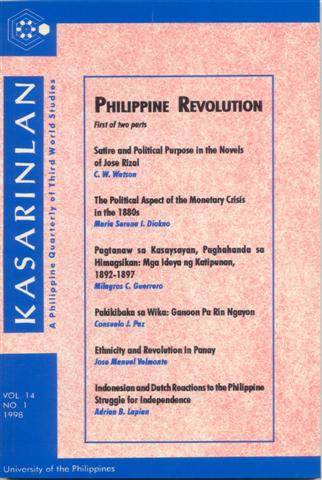Pakikibaka sa Wika: Ganoon Pa Rin Ngayon
Abstract
A century after the revolution that catapulted the Philippines beyond Spanish colonial rule, the battle for the liberation of the Filipino language is still being waged. A common language that will embrace a way of life that is truly of the Filipino people has yet to be established although efforts to establish one have spanned more than a century. During the early stages of the revolution, political ideals were spread through materials mainly written in Spanish. Carrying the message of freedom to the masses proved difficult because three centuries of Spanish rule limited the literacy level of the fragmented Filipino people among members of the ilustrado class, who spoke, thought and wrote in Spanish. There was, however, an attempt by leaders of the revolution to formalize a national language for the Filipinos who needed to be free from Spain and its cultural influence. But first and foremost, the national language, which was still to take shape, was to become a tool of the revolution. Primarily, the people needed to be reminded of their love for the motherland and the need for unity if lasting freedom was to be achieved. This was done through writings in Filipino; never mind if a definitive Filipino grammar was absent. Consequently, the use of a non-Spanish language raised the level of awareness regarding the existence of an indigenous one.Early attempts to use a native language revealed the depth of Spanish influence. It was clear that Spanish orthography and grammar were to be an integral part of the national language that was just starting to take shape. But the proponents of the language revolution were not to give up easily and made significant progress in the formalization of the national language. An example of this is the use of affixes, the grammatical function of which is an integral part of all local dialects. The use of affixes was not yet extensive or uniform given the complex nature of the local vocabulary which was still heavy with Spanish holdovers.
Before any further shaping of the national language could take place, the United States established an education system that would shelve the institutionalization of a Filipino language for another hundred years. Without a national language to
prevent the entrenchment of the English language, the latter became the mode of communication among the educated. The non-elite groups were marginalized and barred from participation in government because of the language barrier. At present, the constitutionally assured use of Filipino in governance and education is implemented only in ceremony. Its full implementation is being hampered by globalization. Some argue that proficiency in the English language is necessary for competitiveness in the global village. Hence, efforts to unify the country through language must take a back seat to development. By its very nature, language, however, evolves; it develops to become relevant to the people who speak it or it disappears. It is the people, not the few in power, who must find their own words to transform ideals into destiny. Without their own language a people are doomed to spend at least one more century without a voice. The architects of the revolution were ahead of their time.
Published
2009-07-24
How to Cite
PAZ, Consuelo.
Pakikibaka sa Wika: Ganoon Pa Rin Ngayon.
Kasarinlan: Philippine Journal of Third World Studies, [S.l.], v. 14, n. 1, july 2009.
ISSN 2012-080X.
Available at: <https://journals.upd.edu.ph/index.php/kasarinlan/article/view/1408>. Date accessed: 21 aug. 2025.
Section
Features
By submitting a manuscript, the authors agree that the exclusive rights to reproduce and distribute the article have been given to the Third World Studies Center.



